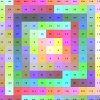Number Theory Seminar
Suppose x and y are permutations which, together, generate a transitive subgroup. For which z is it true that x and the z-conjugate of y also generate a transitive subgroup? The intended application is to the subject of Dessins d'Enfants: a dessin d'enfant (D,X) is a closed oriented surface X with an embedded bicolored graph D whose complement in X is homeomorphic to a union of discs, and such (D,X) are permuted very mysteriously by the Absolute Galois Group G. It is well-known that dessins d'enfants are encoded by transitive permutation pairs (x,y), and it is very easy to show that G acts on dessins d'enfants by conjugations as above. A small, but nonetheless thorny, step towards understanding G-orbits of dessins d'enfants is to understand which conjugations are possible, i.e. which conjugations lead again to a transitive pair. Although this work is not yet finished, I am close to complete understanding when z is a transposition. It is possible that an answer for general z may somehow be deduced from this. Central to this is a certain classification of the set of all (x,y) that, in hindsight, is related to Pattern Avoidance.
